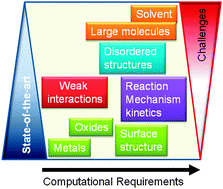State-of-the-art and challenges in theoretical simulations of heterogeneous catalysis at the microscopic level†
Abstract
Theoretical simulations of systems that represent heterogeneous

* Corresponding authors
a
Institute of Chemical Research of Catalonia (ICIQ), Av. Països Catalans 16 – 43007 Tarragona, Spain
E-mail:
nlopez@iciq.es
Fax: +34 977920231
Tel: +34 977920200 (Ext. 307)
b Department of Chemistry, CICECO, University of Aveiro, P-3810-193 Aveiro, Portugal
c Department of Chemical Engineering, Stanford University, Stanford, USA
Theoretical simulations of systems that represent heterogeneous

 Please wait while we load your content...
Something went wrong. Try again?
Please wait while we load your content...
Something went wrong. Try again?
N. López, N. Almora-Barrios, G. Carchini, P. Błoński, L. Bellarosa, R. García-Muelas, G. Novell-Leruth and M. García-Mota, Catal. Sci. Technol., 2012, 2, 2405 DOI: 10.1039/C2CY20384G
To request permission to reproduce material from this article, please go to the Copyright Clearance Center request page.
If you are an author contributing to an RSC publication, you do not need to request permission provided correct acknowledgement is given.
If you are the author of this article, you do not need to request permission to reproduce figures and diagrams provided correct acknowledgement is given. If you want to reproduce the whole article in a third-party publication (excluding your thesis/dissertation for which permission is not required) please go to the Copyright Clearance Center request page.
Read more about how to correctly acknowledge RSC content.
 Fetching data from CrossRef.
Fetching data from CrossRef.
This may take some time to load.
Loading related content
